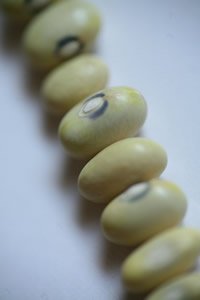
(Vegetarian, vegan/gluten-free option)
So this is embarrassing: when I was a kid, I used to play like I was a Hutterite. The embarrassing part (aside from you now envisioning me in make-believe games) is that I didn’t really know what a Hutterite was, and still don’t, entirely. It wasn’t their pacifist ideals or their community living, or even their great soup beans, that appealed to me. No, I was pretending to be a Hutterite because I liked the sound of the word.
All those harsh consonants and assertive vowels. A fast word, almost an imprecation. Something hurled at the car engine when your tinkering failed to make it ignite. The word opened all sorts of possibilities to my imagination.
I was a nerdy, wordy kid. Even my dress up games were word games.
I did look it up in an encyclopedia. There I was, 8 or 9 years old, and struck almost wordless (almost) by the fact that the Hutterites didn’t allow their members to wear aggressive uniforms – no cops, no military. The notion seemed mystical to me, more than anything. Being a Catholic school girl, I couldn’t imagine the absence of uniform. I liked it.
So it was with a strange sense of wonder that I responded to the discovery of the Hutterite Soup Bean, sitting pale and pretty on page 9 of the Seed Saver’s Exchange catalog. You can imagine my thrill when I discovered that they also sold them as eating beans.
I think that at the end of this year, these little beans will be very close to the top of my list. Unremarkable in appearance (unlike the Hutterite people, who often wear vibrant colors, unusual for a religious sect), the Hutterite Soup Bean is delicate and creamy, almost buttery. It’s no wonder then that when the Hutterites fled persecution in Eastern Europe and headed for North America, they packed the bean and brought it too.

The Soup Bean seems to have more natural oils than most beans, and so even though it’s dense it also melts in your mouth. In this recipe, I made a half-hearted attempt to mash some of the beans, and they were very agreeable (pacifists too, I guess). It strikes me that this would be a good chowder or hummus bean.
The Hutterite Soup Bean has made it onto the SlowFoods Ark of Taste. Seed Saver’s Exchange notes in their catalog that it’s on the “more endangered” section of the Ark, so if you’re looking for a dry bean to grow this season, this might be a good one. Also, I’ve read that it’s hardy, fast-growing and productive in the garden. And saving beans for genetic purity is relatively easy (but more on that as we get closer to gardening season).
The Recipe:
Like a lot of my soups and stews will, this one looks complicated. I promise, it’s not. It has fewer steps than the seafood chili because essentially you just dump it all in a pot, but it does have a daunting number of ingredients. It’s partly because I’m cooking without meat and have to build the complexity of flavor another way. It’s also because, as I explained in my first recipe, I layer my flavors, going for base notes, middle tones and a high finish. When you lift the lid during cooking, this soup gives off a rich, caramel aroma.
The ingredients are negotiable. Everything is in cooking. I really want to encourage you to trust your senses, to feel your way through food preparation, and to be open to the unexpected. That said, if you follow this recipe you’ll get a happy result.
So here we go:
Hutterite White Bean Soup
Ingredients:
Parmesan rind (not essential, but start saving those now because they are great for soup, and if you already save them then you know what I’m talking about).
1 tablespoon olive oil
1 large white or yellow onion, diced
5 cloves garlic, crushed
3 stalks celery, diced
1 small jalapeno, seeds removed
3 carrots, diced
2 potatoes, cut into small cubes (you can leave skin on – up to you)
6 cups vegetable stock
¼ cup chili sauce
½ cup fresh cilantro
½ cup fresh parsley
2 1/2 cups pre-cooked Hutterite Soup Beans
Seasoning:
2 bay leaves
1 teaspoon thyme
2 tablespoons cumin
1 teaspoon coriander
½ – 1 teaspoon dried jalapeno
2 teaspoons oregano
1 teaspoon paprika
Salt and pepper
Garnish:
Asiago shavings (or other hard sharp cheese)
Asiago croutons (recipe below)
In a skillet, heat olive oil on medium until it’s hot and then sauté the garlic and onion until it’s translucent, about 3 minutes. Add the jalapeno, carrots and celery, and cook another minute or two. Even though the veggies will soften as the soup cooks, I’ve learned from experience that sautéing them first helps them retain their texture.
Add the vegetable stock and the potatoes. If you have a rind from a hard cheese, add this to the water too. Add the dry seasonings (bay leaf, thyme, cumin, oregano, coriander, paprika and dried jalapeno), plus salt and pepper to taste. Add chili sauce and the beans, bring to a boil and then reduce heat and simmer for 30 minutes.
When the soup is getting near done, scoop up some of the beans with the back of a wooden spoon and gently mash them against the side of the pot. This will thicken the soup and vary the texture. Stir them back in, then taste the soup and adjust seasonings to your preference. Remove the bay leaves and the cheese rind and discard both. Add the fresh parsley and cilantro, and cook for another 5 minutes.
Before serving, garnish with Parmesan or asiago shavings and croutons.
Asiago Croutons
If you can’t buy them, they’re easy to make. Cut a loaf of asiago cheese bread into small pieces (or for a rustic look, tear them). Heat oven to 375, place bread cubes on baking tray, and let bake for 10-15 minutes, turning once and checking constantly. When they have begun to turn golden, remove them.
Tags: asiago crouton, bean soup, hutterite bean

As a great fan of beans in all their forms and varieties, I have enjoyed reading your posts. But I wonder, shouldn’t it be “beanstalk”? Unless you intend a pun?
Mmmm, creamy, buttery melt-in-your-mouth beans? All the benefits of a vegetable with all the comfort-food satisfying characteristics of a rich, fatty dairy food? Hooray!! I just may have to try this!
Hi Fordalpha,
I’m glad you’re enjoying the posts! If you try any of the recipes, I’d love to know your results. And yes, it is a pun. Since part of the point I’m making is that we have this gorgeous stock of beans available to us, it seemed fitting.
Hi, I found your blog via Google while searching for BAY LEAF and your post regarding Hutterite Bean Soup looks very interesting for me.
Hi Andrew,
It’s fascinating, the search terms that are pulling up my blog! I don’t know how the mind of Google works sometimes (though I can see the bay leaf part)! I’m glad you found the site — let me know if you make the soup.
Becky, I found your blog while looking for something called Refugee Beans. Did not find it but yours is much better I am sure.
I make Bean dished for 50-100 people at the Soup Kitchen, in Red Deer Alberta Canada. I hope it is OK to copy your work off for our crew. We do Vegan when possible, but mostly Veggitarian.
I am very interested in finding these unusual bean seeds to grow here in my garden, as I have been doing this for years, growing shell beans to share with others. I also am a Seed Saver and Organic too. Thank you for your help tonight.
Maggie.
I just got some Hutterite beans and was looking for a soup recipe. Where I live there are tons of Hutterite colonies. I get some of my veggies from them. I ask the ones that I go to the most and they, strangely enough, had never heard of it. I will share some of my “seeds” next year. They are totally amazing people! Are almost as self sufent as the Amish, but use modern convencies. I am anxious to get my beans in the ground and try this recipe!! I found you by putting in the Hutterite Looking forward to trying it.
As one raised on a Hutterite colony I am suprised that I have never heard of Hutterite bean soup or Hutterite beansfor that matter. From your image though, I must say that your beans look an awfull lot like the ones we had when I was growing up but to my knowledge they were not specifically Hutterite beans. We grew ours in the communal gardens and every family received a share of beans to clean and sort for the communal kitchen. We ate them quite simply: boiled in water and seasoned to taste.
All this talk of food is making me hungry! Where can I get some of these wonderful beans?
Interesting observation of what some people think about the Hutterites. I have noted that many seed catalogs offer “Hutterite soup bean” with a lot of misinformation saying that the Hutterites came to the US in the 1700′s! They were in Russia in the 1700′s and didn’t come to US until the 1870′s, all of them coming to South Dakota.
I have lived among Hutterites all my life. I know of none of them using or raising this bean, however, they may have brought it to the US> I have a collection of a number of seeds that they brought from Russia but the seed survived only because the Hutterisch Mennonites kept it alive, not the communal Hutterites. The Hutterites themselves have very readily accepted techknowlegy and modern farming, buying hybrid seeds for their gardens.
I have eaten at a Hutterite colony 175 days a year for the past twenty some years. I know their bean soup is *not* made with the above recipe nor is it made with “Hutterite Soup Beans” but with regular white navy beans.
If you want to know more about Hutterite culture, please visit my website.
Have never heard of Hutterite beans and the recipe is nothing like the bean soup we make. I am a Huterite. Where did you here about this?